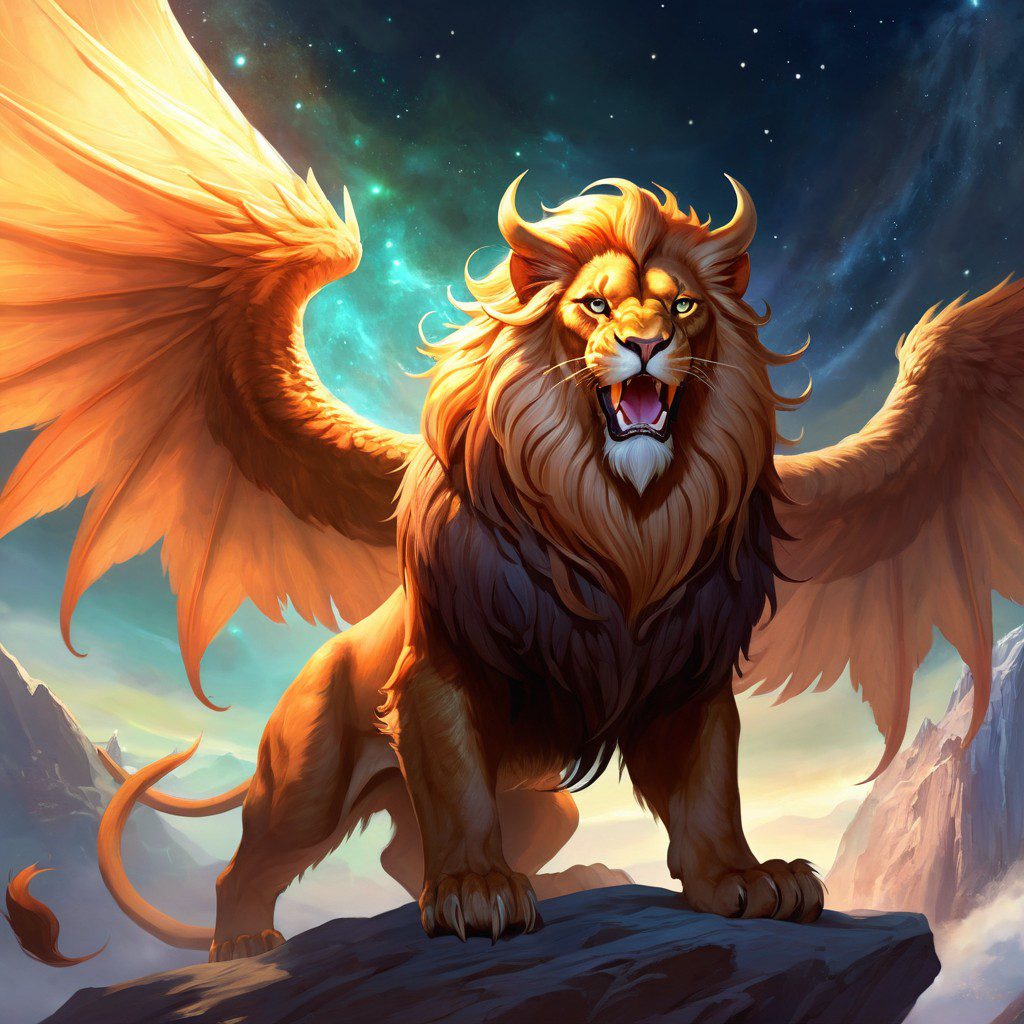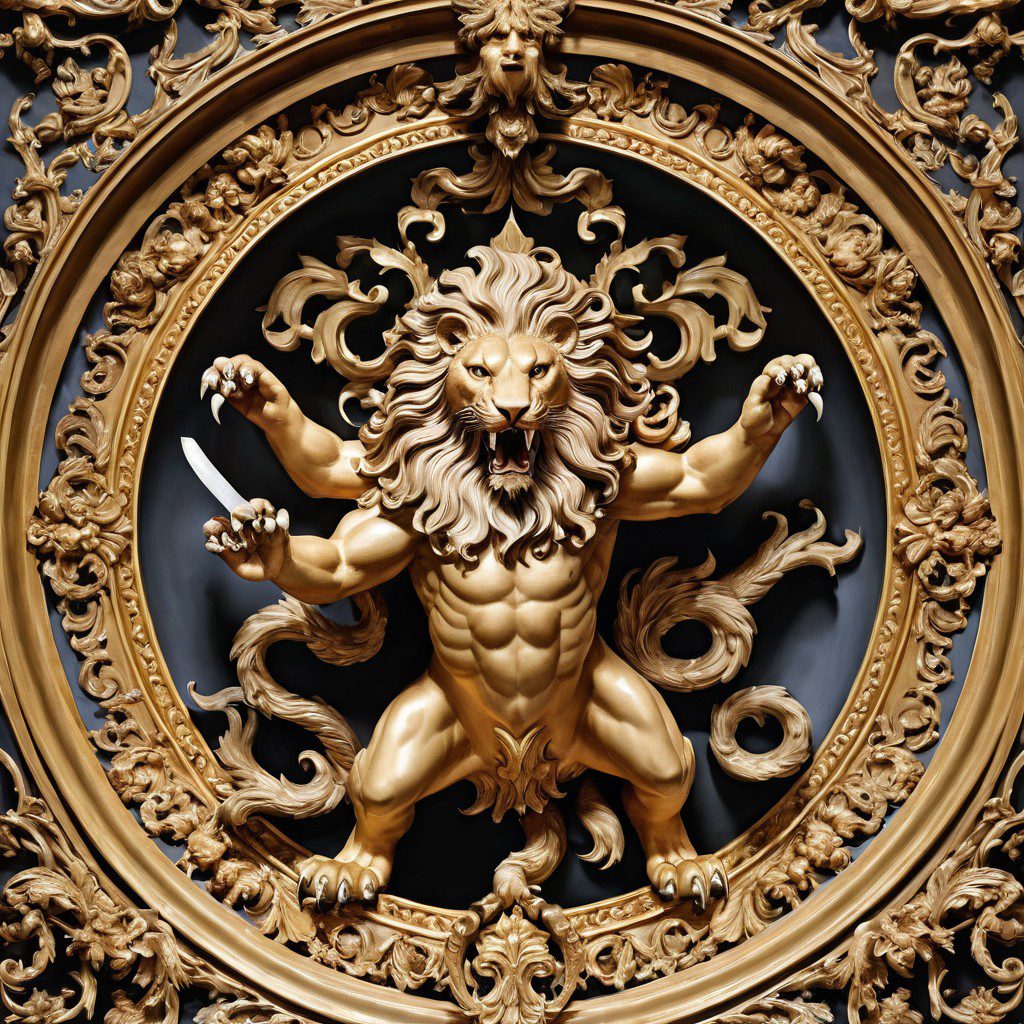The Manticore: The Fearsome Man-Eating Beast of Mythology and Fantasy

The Manticore is a legendary creature from Persian and later Greek mythology, often depicted as a monstrous combination of a lion, a human, and a scorpion or dragon. Known for its fearsome appearance and reputation as a man-eater, the Manticore has become an enduring symbol of danger and savagery in myth and modern fantasy. Its name, derived from the Persian word martikhoras, means “man-eater,” reflecting its deadly nature and insatiable hunger for human flesh.
The Manticore is most commonly described as having the body of a lion, the face of a human, and the tail of a scorpion or dragon, with the ability to shoot poisonous spikes or barbs from its tail. This hybrid nature, combining both the familiar and the monstrous, made the Manticore a creature of terror in ancient lore, and it continues to fascinate and inspire storytellers today.
Origins and Mythological Roots of the Manticore
The Manticore’s mythological origins are believed to lie in ancient Persia, where it was known as a fearsome predator of humans. Its Persian name, martikhoras (later adapted to Greek as mantikhoras), literally translates to “man-eater,” and stories of this creature were passed along through traders and travelers to the Greeks.
The Greek historian Ctesias first recorded the Manticore in the 5th century BCE. Ctesias described the Manticore as a lion-sized creature with a red body, a human face with three rows of sharp teeth, and a tail that shot poisonous spines like arrows. This creature was said to lurk in remote parts of Persia and India, preying on anyone unfortunate enough to cross its path.
In Greek mythology, the Manticore was often considered a cousin of other legendary hybrid creatures like the Chimera and the Sphinx. Like these creatures, the Manticore combined elements of multiple animals, symbolizing chaos and the dangers of the wild. It was frequently depicted as a savage hunter that no human could escape, and its deadly abilities made it a subject of fear and fascination in ancient bestiaries and myths.
Appearance and Traits of the Manticore

The Manticore is known for its grotesque and terrifying combination of animal and human features. Though its description varies slightly across cultures, certain traits are consistent across most depictions.
1. Body of a Lion
The Manticore is usually described as having the body of a lion, which gives it incredible strength, speed, and agility. Its powerful lion’s form allows it to stalk and pounce on its prey with deadly efficiency, much like a natural predator.
2. Human Face
One of the most distinctive and unsettling features of the Manticore is its human face. This anthropomorphic element makes the creature particularly eerie, as it combines human intelligence with animal savagery. In some depictions, the Manticore is said to have three rows of razor-sharp teeth, allowing it to devour humans whole.
3. Tail of a Scorpion or Dragon
The Manticore’s tail is often depicted as its most dangerous weapon. In many versions of the myth, the creature has the tail of a scorpion, equipped with a venomous stinger. Some versions of the Manticore also give it the ability to shoot poisonous spikes or barbs from its tail, which can paralyze or kill its prey from a distance. In other stories, the tail is depicted as dragon-like, capable of lashing out and delivering deadly strikes.
4. Wings (Optional)
In some later depictions, especially in medieval bestiaries and modern fantasy, the Manticore is given bat-like wings, adding to its terror by granting it the ability to fly. This feature is not universal but has become more common in artistic representations of the creature over time.
Abilities and Powers of the Manticore
The Manticore is depicted as an exceptionally dangerous predator, possessing a number of abilities that make it a fearsome foe in myth and fantasy.
1. Deadly Venom and Spines
The most common ability associated with the Manticore is its venomous tail, which is capable of delivering deadly stings or launching spikes from a distance. These spikes are often described as being able to pierce armor and kill a target instantly, either through sheer force or by injecting venom into the victim. This makes the Manticore a dangerous adversary both in close combat and at range.
2. Savage Intelligence
Though primarily a bestial predator, the Manticore is sometimes portrayed as possessing human-like intelligence, which makes it even more dangerous. Its human face and cunning nature allow it to hunt with strategy, laying ambushes or using the terrain to its advantage. In some stories, the Manticore is capable of speech, further enhancing its role as a more sinister and malevolent creature.
3. Invulnerability
In certain medieval legends, the Manticore is described as having nearly invulnerable skin, which makes it impervious to conventional weapons. This attribute adds to the creature’s fearsome reputation, as it can only be killed through magical or extraordinary means. This invulnerability is often associated with its lion-like body, which grants it both physical strength and durability.
4. Man-Eating Hunger
The Manticore’s insatiable hunger for human flesh is a key element of its legend. It is said to devour its victims whole, leaving no trace behind, not even bones. This ability to consume its prey completely adds to the Manticore’s horror, as it often leaves no evidence of its attacks, making it a near-mythical terror that can strike and disappear without a trace.
The Manticore in Medieval Bestiaries
During the Middle Ages, the Manticore became a popular subject in bestiaries—medieval texts that cataloged both real and mythical animals. In these bestiaries, the Manticore was often depicted as a symbol of savagery, chaos, and the untamed wilderness. Its monstrous appearance and man-eating habits made it a symbol of the dangers lurking beyond the borders of human civilization.
Medieval bestiaries often gave the Manticore additional symbolic meanings, portraying it as a representation of sin or heresy. Its combination of human and animal traits was sometimes seen as a distortion of the natural order, symbolizing the blending of good and evil or the corrupting influence of base instincts on the human soul.
Modern Depictions of the Manticore
The Manticore has continued to inspire fear and fascination in modern times, appearing in a wide range of literature, film, video games, and role-playing games. Its unique blend of human and animal traits, along with its deadly abilities, make it a versatile and terrifying monster in many fantasy settings.
1. Dungeons & Dragons
In Dungeons & Dragons (D&D), the Manticore is a well-known creature that frequently appears as an adversary for adventurers. In D&D, Manticores are depicted with bat-like wings, allowing them to fly and attack from above. They retain their ability to shoot spikes from their tail, and their intelligence allows them to lay traps or ambush unwary travelers. Manticores in D&D are typically portrayed as aggressive and territorial, attacking anyone who intrudes upon their domain.
2. The Witcher
In The Witcher series of video games and books, Manticores are powerful and dangerous beasts that serve as formidable foes. Their appearance is similar to that of traditional Manticores, with lion-like bodies, venomous tails, and a hunger for flesh. In the game, Manticores are one of the many monstrous creatures that players must hunt and defeat.
3. Other Video Games and Fantasy Media
Manticores also appear in various other fantasy video games, including Final Fantasy, Assassin’s Creed, and Dark Souls. In these games, Manticores are often depicted as powerful enemies or boss monsters that players must overcome. Their ability to attack from both the ground and the air, combined with their deadly venom and spines, makes them formidable opponents.
4. Films and Literature
Manticores appear in various fantasy novels and films, often as fearsome monsters that heroes must slay. In Rick Riordan’s Percy Jackson series, for example, the Manticore appears as a villainous creature that attacks the main characters, using its deadly spines and savage nature to challenge the heroes.
Strengths and Weaknesses of the Manticore
Strengths:
- Deadly Versatility: The Manticore’s combination of powerful physical traits—such as its lion-like strength, venomous tail, and ability to shoot spikes—makes it a versatile and dangerous predator, capable of attacking from multiple ranges.
- Flight (in some versions): In modern depictions, Manticores are often given wings, allowing them to attack from the air and swoop down on unsuspecting prey, making them even more dangerous.
- Intelligence: Manticores are often depicted as more intelligent than typical animals, allowing them to strategize, ambush, or manipulate their prey. This makes them cunning adversaries, not just mindless beasts.
- Invulnerability (in some myths): In medieval bestiaries, Manticores were sometimes described as being invulnerable to normal weapons, requiring magical means to be defeated.
Weaknesses:
- Overconfidence: Due to their intelligence and power, Manticores are sometimes depicted as arrogant, believing themselves to be unstoppable. This overconfidence can be exploited by clever heroes who use strategy to outwit the beast.
- Vulnerable to Magic: While physically imposing, Manticores are often susceptible to magic, as their invulnerable skin can be bypassed by magical weapons or spells.
- Solitary Nature: Manticores are often depicted as solitary creatures, which can make them vulnerable if outnumbered or overwhelmed by groups of enemies.
The Legacy of the Manticore: A Symbol of Savagery and Fear
The Manticore remains one of the most iconic creatures in myth and fantasy, representing the terrifying blend of human intelligence and animal ferocity. Its man-eating nature, venomous tail, and monstrous appearance make it a symbol of the dangers that lie beyond the safety of civilization. From its roots in ancient Persia to its role in modern fantasy literature and games, the Manticore continues to captivate audiences with its savage power and deadly abilities.
Whether it appears as a cunning predator, a fearsome beast, or a symbol of untamed chaos, the Manticore’s legend endures as a reminder of the wild and dangerous forces that lurk in the shadows of myth.
